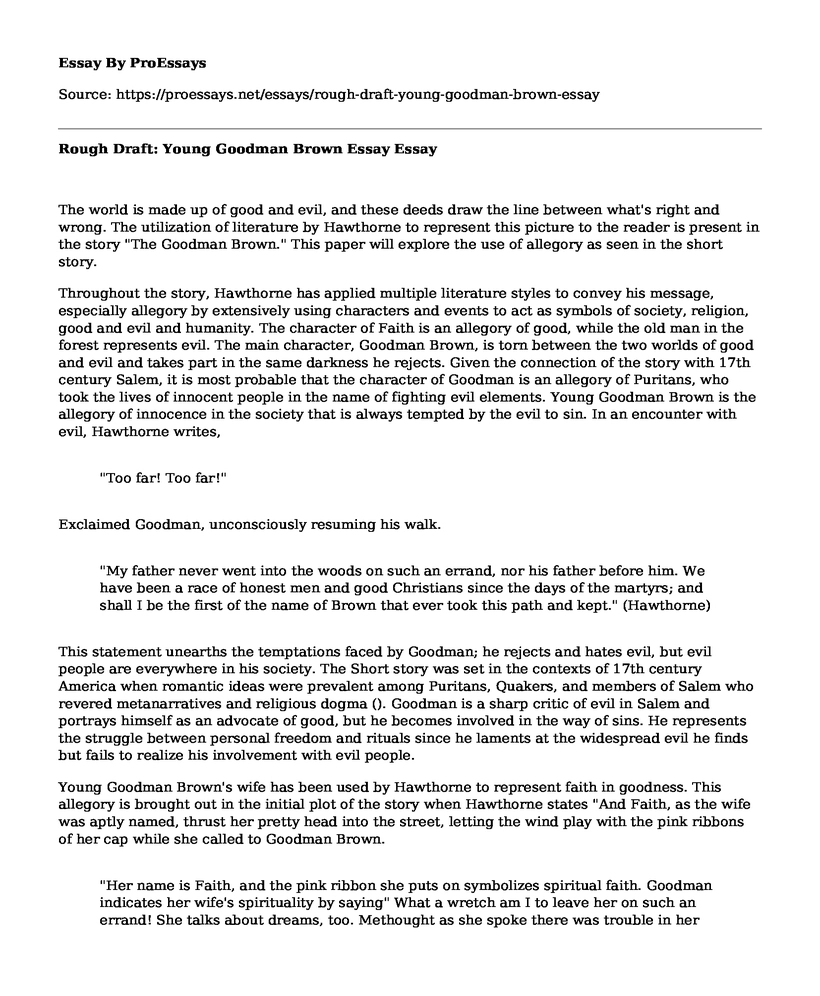The world is made up of good and evil, and these deeds draw the line between what's right and wrong. The utilization of literature by Hawthorne to represent this picture to the reader is present in the story "The Goodman Brown." This paper will explore the use of allegory as seen in the short story.
Throughout the story, Hawthorne has applied multiple literature styles to convey his message, especially allegory by extensively using characters and events to act as symbols of society, religion, good and evil and humanity. The character of Faith is an allegory of good, while the old man in the forest represents evil. The main character, Goodman Brown, is torn between the two worlds of good and evil and takes part in the same darkness he rejects. Given the connection of the story with 17th century Salem, it is most probable that the character of Goodman is an allegory of Puritans, who took the lives of innocent people in the name of fighting evil elements. Young Goodman Brown is the allegory of innocence in the society that is always tempted by the evil to sin. In an encounter with evil, Hawthorne writes,
"Too far! Too far!"
Exclaimed Goodman, unconsciously resuming his walk.
"My father never went into the woods on such an errand, nor his father before him. We have been a race of honest men and good Christians since the days of the martyrs; and shall I be the first of the name of Brown that ever took this path and kept." (Hawthorne)
This statement unearths the temptations faced by Goodman; he rejects and hates evil, but evil people are everywhere in his society. The Short story was set in the contexts of 17th century America when romantic ideas were prevalent among Puritans, Quakers, and members of Salem who revered metanarratives and religious dogma (). Goodman is a sharp critic of evil in Salem and portrays himself as an advocate of good, but he becomes involved in the way of sins. He represents the struggle between personal freedom and rituals since he laments at the widespread evil he finds but fails to realize his involvement with evil people.
Young Goodman Brown's wife has been used by Hawthorne to represent faith in goodness. This allegory is brought out in the initial plot of the story when Hawthorne states "And Faith, as the wife was aptly named, thrust her pretty head into the street, letting the wind play with the pink ribbons of her cap while she called to Goodman Brown.
"Her name is Faith, and the pink ribbon she puts on symbolizes spiritual faith. Goodman indicates her wife's spirituality by saying" What a wretch am I to leave her on such an errand! She talks about dreams, too. Methought as she spoke there was trouble in her face as if a dream had warned her what work is to be done tonight ... she's a blessed angel on earth, and after this one night I'll cling to her skirts and follow her to heaven."(Hawthorne)
Young Brown further notes that Faith nurtured his good character for a while, which shows her deep personal connection to personal morality, goodness, and faith. It is clear that faith is the impetus that tried to keep Goodman from evil ways. Goodman meets a fifty-year-old character who represents evil, and Hawthorne writes that the only thing about him that could be fixed upon as remarkable was his staff, which bore the likeness of a great black snake, so curiously wrought that it might almost be seen to twist and wriggle itself like a living serpent. This, of course, must have been an ocular deception, assisted by the uncertain light '.
By relating the character to an old snake, Hawthorne implies that Young Goodman was in the company of someone capable of evil and deception, an embodiment of all that is undesirable and devilish. This allegory is used to indicate that innocence does not necessarily mean freedom from evil temptations, but even good people can be involved in evil without realizing it. Additionally, the snake-like figure if the old man indicates the treacherous nature of evil people.
Throughout the short story, Goodman Brown maintains his good character in the midst of an evil society. His role symbolizes a naive and curious in the midst of good and evil. His support comes from Faith, a spiritual character described by Hawthorne as an embedment of Christian faith. On the other end of the spectrum, evil is represented by the role of an old man in the forest who befriends Brown Goodman. This allegory can be seen to have a broader meaning other the literary concept that illustrates spiritual truth and events in the character's life related to the readers' world. The allegory in Hawthorne's story is characterized using symbolism that fills the entire story, such that significant characters like Goodman Brown and their actions have a unique symbolic significance.
Works Cited
Hawthorne, Nathaniel. Young Goodman Brown. Booklassic, 2015.
Cite this page
Rough Draft: Young Goodman Brown Essay. (2022, Apr 14). Retrieved from https://proessays.net/essays/rough-draft-young-goodman-brown-essay
If you are the original author of this essay and no longer wish to have it published on the ProEssays website, please click below to request its removal:
- Poem Analysis Essay on The Rape of the Lock
- Directed Writing on Beowulf Essay
- Critical Essay on Oedipus the King
- Grief and Denial: William Faulkner's A Rose for Emily - Research Paper
- Uncovering the True Author of Shakespeare's Works - Essay Sample
- Tragic Cultural Literacy: Understanding Biblical Poetry - Essay Sample
- Macbeth & Lady Macbeth: Contrasting Degrees of Evilness







